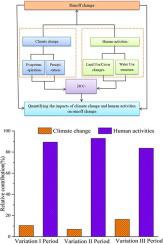Ecological Indicators ( IF 6.9 ) Pub Date : 2020-10-12 , DOI: 10.1016/j.ecolind.2020.107013 Dongxiang Xue , Junju Zhou , Xi Zhao , Chunfang Liu , Wei Wei , Xuemei Yang , Qiaoqiao Li , Yaru Zhao

|
The Shiyang River Basin is a typical arid watershed in Northwest China. Scientific understanding of the driving mechanism of runoff change is the basis of scientific utilization of water resources and regional sustainable development. In this study, runoff changes at different time scales were analyzed for the period 1960–2018, and the impacts of climate variability and human activities on runoff were investigated in the middle and lower reaches of the Shiyang River Basin (SRB). A combination of mutation analysis and human-designed analysis was adopted to divide the study period into the baseline period and the variation period. The Mann–Kendall test (M−K) and Double Mass Curve method (DMC) were used to detect abrupt changes and quantify the relative effects of climate change and human activities on runoff. The results reveal a significant declining trend in annual runoff on the whole in the middle and lower reaches of the SRB, and there was an obvious recovery trend after the implementation of the Comprehensive Treatment Program of the SRB (CTSRB) in 2007. Abrupt changes occurred in 1976, 1991 and 2007, which divided the study period into the baseline period (1960–1975), the Variation Ⅰ period (1976–1990), the Variation Ⅱ period (1991–2006) and the Variation III period (2007–2018). The contribution of human activities to runoff reduction was 88.72%, whereas the contribution of climate change to runoff reduction was only 11.28%. Furthermore, the contribution of human activities to runoff reduction in the Variation Ⅰ period, Variation Ⅱ period and Variation III period was 89.44%, 93.02% and 83.69%, respectively. Therefore, human activities played the most dominant role in the variation of runoff, followed by climate change and upstream runoff. Further analysis of the impact of human activities on runoff indicated that agricultural irrigation was the dominant factor of runoff reduction. This study can provide detailed information on water resources and a scientific basis for the development and utilization of water resources in the future.



























 京公网安备 11010802027423号
京公网安备 11010802027423号